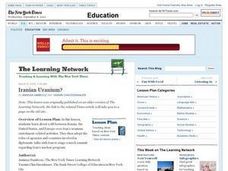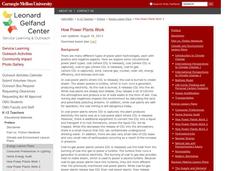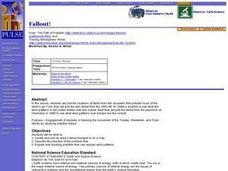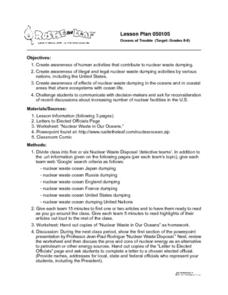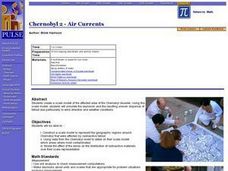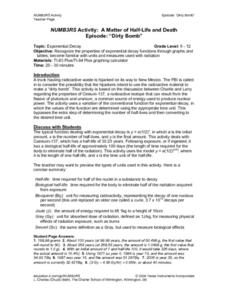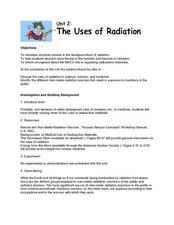Curated OER
Iranian Uranium?
Students explore how Iran's uranium enrichment-related activities has caused a rift between Russia, the United States, and Europe. They stage a mock summitt to discuss Iran's nuclear program.
Curated OER
CONVECTION
Students experiment to produce a visual convection current in the classroom and compare it to the images taken of convection cells in the Sun. They analyze the source of the Sun's energy and this type of energy transport.
Curated OER
Forces And Energy
Students investigate the atom and how it is formed. They conduct research using a variety of resources and then construct a model of the atom. Then students have class discussion. The instructional activity includes background...
Carnegie Mellon University
How Power Plants Work 3
Double, double toil and trouble, fire burn and cauldron bubble! Find out what drives a turbine to generate electricity and whether or not it has an impact on the environment. A discussion and lecture is divided by a hands-on activity in...
Curated OER
Fallout
Students view a short film about the results of dropping the atomic bomb at the end of World War II. They research controversies surrounding the use of the bomb and nuclear weapons. They write two editorials about the issue.
Curated OER
Oceans of Trouble
Middle schoolers investigate the illegal and legal nuclear waste dumping activities by various nations, including the United States. The effects of nuclear waste dumping in oceans and in coastal areas that share ecosystems with ocean...
Virginia Department of Education
Predicting Products and Writing Equations
A chemistry lesson presents 14 chemical reactions for scholars to observe, write the equation, and balance the equations. Additionally, it provides ways to extend the activity as it relates to catalysts.
Curated OER
Transportation Choices and the Environment
Students study statistics and charts pertaining to how transportation and other energy choices impact the environment. They participate in small group discussions regarding concerns for the future.
Curated OER
Mississippi’s Electricity: From Generation to Consumption
Eighth graders discover how electricity is produced. In this physics lesson plan, 8th graders infer about the future of Mississippi's energy industry. They participate in a Smart Board interactive activity at the end of the lesson plan.
Curated OER
Government: The Power Grab
Students are able to identify the departments and agencies within the executive branch that enforce energy policy. They are able to describe potential concerns that the executive branch must address when developing energy policy.
Curated OER
Chemistry E3 Lesson Plan
Ninth graders perform a series of experiment to investigate heat transfer and phase changes. In this physical science lesson, 9th graders identify and calculate the different subatomic particles. They explain the importance of scientific...
Curated OER
Chernobyl 2 - Air Currents
Young scholars create a scale model of the affected area of the Chernobyl disaster. Using this scale model, they simulate the explosion and the resulting uneven dispersal of fallout due particularly to wind direction and weather conditions.
Curated OER
The Magma Also Rises
Convection is thoroughly demonstrated using a model of Earth's mantle. Detailed background information is provided for the teacher, as well as a list of materials. Although a colorful and detailed worksheet is available for the class,...
Curated OER
Fossil Fuels vs. Alternative Fueling Systems
Fourth graders brainstorm the differences between the fossil fuels that people use in their transportation now and what they could use to minimize greenhouse gas emissions. They use a variety of techniques from webquests to writing...
Curated OER
Radiation: To Worry or Not to Worry
Students distinguish safe forms of radiation from those that are dangerous. Students watch a video about sources of radiation encountered every day. Students estimate their own annual radiation exposure.
Curated OER
Radiation: To Worry or Not to Worry
Students distinguish safe forms of radiation from those that are dangerous. Students watch a video about sources of radiation encountered every day. Students estimate their own annual radiation exposure.
Curated OER
Cell Structures and Functions
Fifth graders search into animal and cell characteristics and their functions in this seven instructional activity unit. Replicas of the cell are constructed out of Jell-O as students probe the internet for details of the concepts.
Curated OER
NUMB3RS Activity: A Matter of Half-Life and Death
Students investigate exponential decay. Students explore the biological half-life of Cesium-137. Students investigate the Goiania Accident of 1987 which is considered one of the worst incidents in the history of the Atomic...
University of Texas
Lives of Stars
Stars exist from a few million years to over 10 billion years, depending on their mass. Scholars perform a play acting as stars to learn about their different life cycles. They develop an understanding of many of the fundamental concepts...
Kenan Fellows
Half-Life
Scholars shake their way to understanding half-life with the help of candy. They observe and record which side candy lands on to graph the exponential decay in the fifth lesson of seven integrating chemistry and algebra. Combining...
Cornell University
Isotope Rummy
Thanks to this game, teaching isotopes will never be the same. Physical science scholars work their way toward understanding isotopes in an entertaining game. Pupils play rummy in groups while practicing good sportsmanship and creating...
Virginia Department of Education
Properties of Compounds and Chemical Formulas
Young chemists have unknown compounds they need to sort. Performing three different tests on each, the chemical behaviors they observe become the basis for data analysis.
Curated OER
The Uses of Radiation
No visual aids, no activities, and no demonstrations accompany this plan. What you will find, is background information for a short lecture on the use of isoptopic radiation in the medical field and in our everyday lives. Should you...
Virginia Department of Education
Determining Absolute Age
How can radioactive decay help date old objects? Learners explore half-life and radioactive decay by conducting an experiment using pennies to represent atoms. Young scientists graph data from the experiment to identify radioactive decay...


